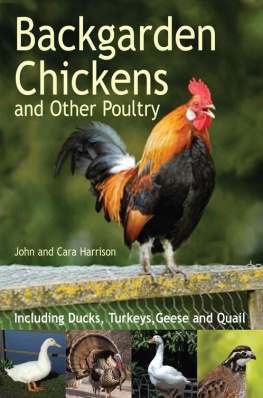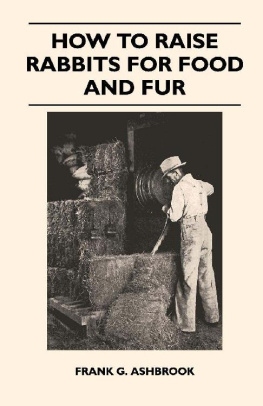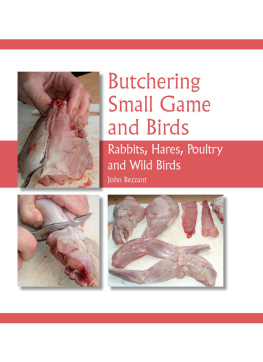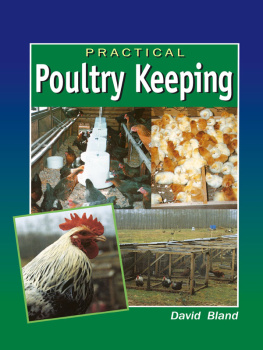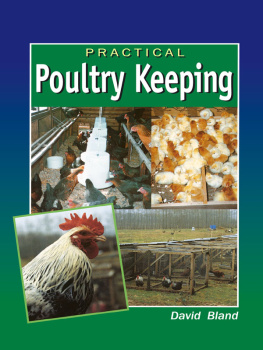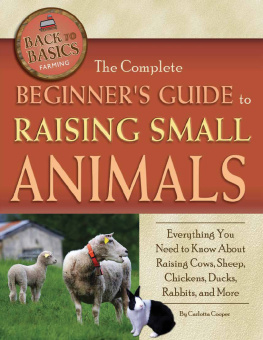ABOUT THE AUTHORS
Alan Thompson, author of the Poultry section of this book, kept poultry from the moment he left school. He obtained his technical knowledge at Harper Adams College and was Editor of Poultry Farmer for 15 years. He also farmed poultry at Courthouse Farm in Copthorne, Sussex, and his voice was familiar to all those who listened to the BBCs poultry talks.

Claude Goodchild, author of the Rabbit section of this book, spent the first 35 years of his life on an Essex farm and bred rabbits on a considerable scale from the age of 15. He went on to run the largest rabbit farm of its time in England at Black Corner, near Crawley, Sussex. He started the Rex rabbit in England, was among the first to breed Chinchillas and visited many parts of the continent in an advisory capacity, including Russia at the invitation of the Soviet Government. He once fulfilled an order from the USA for 15,000 Chinchillas.

Keeping Poultry
AND
Rabbits on Scraps

BY
ALAN THOMPSON
AND
CLAUDE H . GOODCHILD

PENGUIN BOOKS
HARMONDSWORTH MIDDLESEX
PENGUIN BOOKS
Published by the Penguin Group
Penguin Books Ltd, 80 Strand, London WC2R 0RL , England
Penguin Group (USA) Inc., 375 Hudson Street, New York, New York 10014, USA
Penguin Group (Canada), 90 Eglinton Avenue East, Suite 700, Toronto, Ontario, Canada M4P 2Y3
(a division of Pearson Penguin Canada Inc.)
Penguin Ireland, 25 St Stephens Green, Dublin 2, Ireland (a division of Penguin Books Ltd)
Penguin Group (Australia), 250 Camberwell Road, Camberwell, Victoria 3124, Australia
(a division of Pearson Australia Group Pty Ltd)
Penguin Books India Pvt Ltd, 11 Community Centre, Panchsheel Park, New Delhi 110 017, India
Penguin Group (NZ), 67 Apollo Drive, Rosedale, North Shore 0632, New Zealand
(a division of Pearson New Zealand Ltd)
Penguin Books (South Africa) (Pty) Ltd, 24 Sturdee Avenue,
Rosebank, Johannesburg 2196, South Africa
Penguin Books Ltd, Registered Offices: 80 Strand, London, WC2R 0RL, England
www.penguin.com
First published by Penguin Books 1941
This facsimile edition published 2008
All rights reserved
Except in the United States of America, this book is sold subject to the condition that it shall not, by way of trade or otherwise, be lent, re-sold, hired out, or otherwise circulated without the publishers prior consent in any form of binding or cover other than that in which it is published and without a similar condition including this condition being imposed on the subsequent purchaser
ISBN: 978-0-14-190345-3
CONTENTS
EGGS FROM SCRAPS
By A LAN T HOMPSON
Editor PoultryFarmer
T HE hens egg is the finest concentrated food known to man. It is produced by a humble, and slightly ridiculous, creature whose remarkable qualities have never been justly appreciated.
A hen not only lays eggs: she grows corn and cabbages, onions and oats. As a Wiltshire farmer once observed if my birds never laid another egg I would still keep them for their scratching and fertilising benefits to the soil.
Over a million people keep hens but few produce eggs with the utmost economy. Spacious grass range is not necessarily an advantage in this respect. Some of the best and most economical production is found in tiny city backyards.
The purpose of these pages, however, is to show how the maximum number of eggs can be obtained from the minimum amount of imported food. The hen will be introduced in a sober light with no attempt to extol its virtues at the expense of its weaknesses.
Let us first of all present the disadvantages of poultry keeping.
SNAGS IN POULTRY KEEPING
These can be summarised as follows: Disease, time and expense.
Unfortunately through indiscriminate breeding for very high production there are a number of strains which are either infected with disease or show little resistance to it.
Such birds are not only to be found in the hands of dealers at street and auction markets, but also on general farms. Such stock can, however, easily be avoided if precautions are taken which are outlined later.
The time and labour involved are such as to be expected in the keeping of any livestock. The work of attending to poultry is relatively small, but it is constant. Unless the laying cage system is adopted the birds want food twice a day and cleaning out at least once a week. A hen is not a Hoover which can be put away at week-ends.
As to the expense, this is dependent upon whether the poultry keeper is prepared to build or adapt his own appliances. If he is, the outlay can be negligible. But if not, as is more probable, the total expense of house and stock may vary between 7 and 20.
As compensation, it should, however, be pointed out that the owner has equipment which, with regular creosoting or tarring, will last him his lifetime and few give up if they have once started with healthy stock. It is also reasonable to assume that the greater part, if not the whole, of the initial outlay will be paid for in the first year of lay out of profits from eggs over food.
This is without considering the benefits of a regular supply of new laid eggs and improved fertility of the garden.
THE START
Let us now consider how to start.
It would be proper to deal with equipment first, but let us take the hen before the house as she is the one vital factor in making a success of poultry keeping.
Although the beginner has the Domestic Poultry Keepers Council placed at his disposal by the Government it is not in a position to supply stock.
It can, however, offer advice as to potential sources of supply.
So can the County Poultry Instructors, and the beginner should not hesitate to consult the Poultry Press or the Experts on the trade papers, as he cannot take too much pains over the initial source of supply.
The Press, in fact, recognises this, for readers of the poultry and agricultural press are safeguarded from the dishonest dealer by the Poultry Advertisement Control Board which ensures that only suppliers of repute are allowed to advertise; and provides an Approval System by which the money for the purchase is not handed over to the seller until the goods have been received and, within 48 hours, approved.
The Board has also laid down the following definitions for various classes of stock and where the seller refuses to accept the Approval or Deposit System and is evasive in regard to the following definitions his offers should be treated with suspicion:
POULTRY AND FARM ADVERTISEMENT CONTROL BOARD REGULATIONS
C HICKS must be advertised as (1) Guaranteed not sexed; (2) Sexed pullets; (3) Sexed cockerels; (4) Sex-linked pullets or (5) Sex-linked cockerels.
F EMALE P OULTRY S TOCK must be advertised as (1) P ULLETS (birds up to 12 months old) and the month of hatching must be stated (e.g. September pullets); (2) Y EARLINGS (12 to 24 months) and both the month and year of hatching must be stated (e.g. May 1940 yearlings) or (3) H ENS (over 24 months).
WHICH BREED ?
The first and very natural question that every beginner asks is what breed should be kept?
Next page


